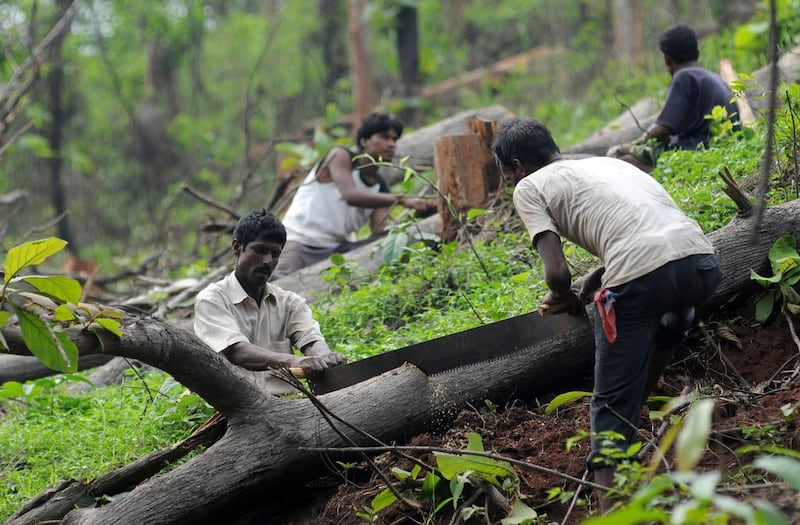India’s environment ministry is preparing to disburse 400 billion rupees (Dh22bn) to state governments to plant thousands of hectares of new trees, but experts are not convinced that this will be enough to reverse the damage to the country’s forest cover.
Bureaucrats from state governments met in New Delhi on Friday and Saturday to consult with the environment ministry about the rules by which these funds will be distributed. The rules will be framed within a month, said S S Negi, the director general of forests.
The money has been accumulated since 1980, when the Forest Conservation Act stipulated that for every diversion of forest land for other purposes, an equal land area must be planted with forests to maintain India’s forest cover.
Since then corporations and government agencies have had to pay into a forestation fund when buying or taking over forested land to be cleared and used for purposes approved by the authorities. Payments range from 438,000 rupees to 1.04 million rupees per hectare, depending on the quality of the forest.
On average the government now receives 60 billion rupees a year from such payments, which are earmarked for afforestation – the planting of new forests in areas where there was previously no forest cover.
So far, however, the environment ministry has been disbursing very little of this money to states. The last survey of India’s forests showed a 0.18 per cent increase in forest cover between 2010 and 2012, but most of this increase was a result of correcting a data error from the previous survey.
In the same survey, 15 of India’s 29 states – including some of the most thickly forested, such as Maharashtra and the seven northeastern states – reported a decline in forest cover.
Noting the government’s lethargy in distributing afforestation money, the supreme court in 2002 directed the establishment of a new bill for such funds. It took until last year, however, for an afforestation draft law to be introduced into parliament. The bill was passed in July.
But Neera Singh, a professor in the University of Toronto’s faculty of forestry, said that the very idea of planting fresh forests was flawed.
"Plantations are a very poor substitute for natural forests, as they can never replicate the biodiversity present in a natural forest," Dr Singh told The National. "Mostly, plantations include fewer tree species, are often monocultures that use up a lot of water, and have a negative environmental impact."
The term “monocultures” refers to large plantations of a single species of tree – teak, for instance, or bamboo. A natural forest, however, automatically incorporates several species of plants and trees.
Previous afforestation efforts by the Indian government have ended up in creating monoculture forests, often consisting of trees deemed commercially valuable.
“[These efforts] have not been successful, as plants have not survived and frequently they are not native to the area,” Ajay Kumar Saxena, the programme manager for forestry at the Centre for Science and Environment, a New Delhi-based non-profit organisation.
“Therefore, these plantations do not restore local ecology” and only produce timber, he said, adding that this meant they were not useful for locals. A natural forest’s mix of plants and trees can support a richer ecosystem, which balances the intake of nutrients from the soil. This keeps the soil in the area rich and better for growing crops.
Nandikesh Sivalingam, a campaigner for forests at Greenpeace India, said the government would be better off preventing further damage to India’s forest cover, rather than permitting the felling of old-growth forests to satisfy the industrial sector’s appetite for land.
Mr Sivalingam also worried that the government had made no plans to consult village councils and tribes that live in and around degraded forests or forested land being sold or taken over, contravening the Forest Rights Act (FRA) of 2006.
“Community forest rights should be identified, and they should be given the right to conserve and manage the forests as per the FRA,” he said. “With community forests, conservation and resource use plans should be created at the village level, and the state should assist village councils with funds and technical support wherever necessary.”
Taking away the rights of these communities, he said, “will only further strengthen the government’s control over natural resources”.
Grass roots initiatives to protect or replenish forests have been successfully implemented in the past in India, Dr Singh said.
“Instead of planting trees, natural forest regeneration with community involvement can be encouraged,” she said. “Village councils should receive money for restoring or regenerating forests.”
But under the current scheme, Mr Sivalingam said, the money is likely to be spent by government departments with little knowledge or experience of how local communities interact with forests.
In the current context of scare land availability, he said, there is now a clear danger of community land being taken away, or natural forests being cut to make way for plantations.
ssubramanian@thenational.ae





